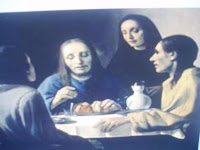
BRUCE MUSEUM
Han van Meegeren’s: The Supper at Emmaus, 1937,
Han van Meegeren was born on October 10, 1889. He was a Dutch painter and art restorer and is considered to be one of the most ingenious art forgers of his time.
When art critics decried his work as tired and derivative, Van Meegeren felt that the critics had attacked him and had destroyed his career. He prove his talent to the critics by forging paintings of some of the world's most famous artists. Van Meegeren spent six years researching techniques, finally producing perfect forgeries of paintings attributed to Johannes Vermeer. He had so well replicated the styles and colours of the artists he copied, even the best art critics and experts of the time regarded his paintings as genuine, and sometimes exquisite, and the techniques he used could not be detected using authentucation a methods of the time.
The Disciples at Emmaus is the most famous of all the van Meegeren forgeries said he kept the strip of canvas and the two pieces of stretcher so removed, but only one piece of stretcher was actually found at his villa by the police. However, the annual rings and a wormhole on this piece of wood matched exactly those on the edge of the stretcher. X-rays revealed the traces of an underlying painted head at approximately the position that van Meegeren had said one would be found. Van Meegeren sold this painting through other people. The cover story was that van Meegeren had been asked to sell this and other pictures, part of a group of Old Masters, by an Old Dutch family now living in Italy. Emmaus works for two days and was examined and then qualified it as an authentic Vermeer, announcing the results in a local magazine.
Dutchmen wanting to prevent a purchaseof Dutch art to Adolf Hitler and the Nazi Party During World War II. Following the war, the forgery was discovered in Goering's possession, and was arrested as a German Collaborator, as the officials believed that he had sold Dutch cutural property to the Nazis. Since Han van Meegeren did not want the death penalty he confessed to the forgeryh. The Christ and the Disciples at Emmaus painting as a Johannes Vermeer work. The commission traced the forgery to Meegeren. His charges were falsification and fraud charges, and was sentenced for one year in prison. He did not go to prision because he died of a heart attack in 1947. Critics said Van Meegeren received over $25–30 million dollars for his forgeries.
Han van Meegeren used curves and shapes convey. Through color and composition the artist established a religious dinner. The function it serves was to copy an original painting on to make a profit form it. Secular reasons was not his intentions they were to only make a profit. The symbolism the work contained were the three individuals sitting around Jesus in the far chair in blue giving them wisdom.
The message I interrupted was a dinner that was prepared for Jesus and the people showing him praise. The people exhibited strong religious belief. The message communicated in this painting is honor. The cultural, political, economic, social or religious influence on the life of the artist and the community in which he/she worked was to show a forgery of an original painting. I see a heavy conversation going on that attracted its listens and they focused on what is being said to them .The composition appears to a day long ago when people had to rely on religion. What stands out the most when I first approaching the work was the attention that was showed to the man in blue. The artist used oil on a canvas, the colors are very soft a give the appearance that it was in a small room of the church.
en.wikipedia.org/wiki/Han_van_Meegeren
essentialvermeer.20m.com/misc/van_meegeren
www.tnunn.ndo.co.uk/emmaus.
The New York Sun, May 10, 2007.

1 comment:
Again... This is a mess... Here is a rehash of a Wikipedia article on vanMeegeren. I don't sense that you went to the Bruce or got the idea of this show.
You can't change a few words and call it your own... it is still plagarism. In waiting until after class was over to post these three papers, you didn't benefit from my help... Now we have a problem.
Post a Comment